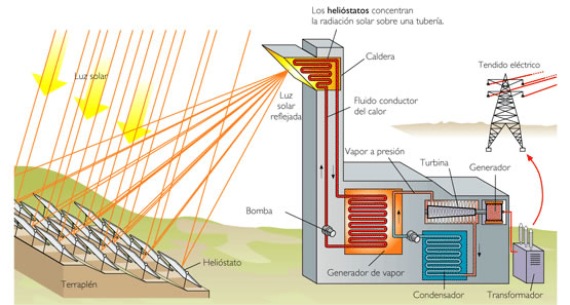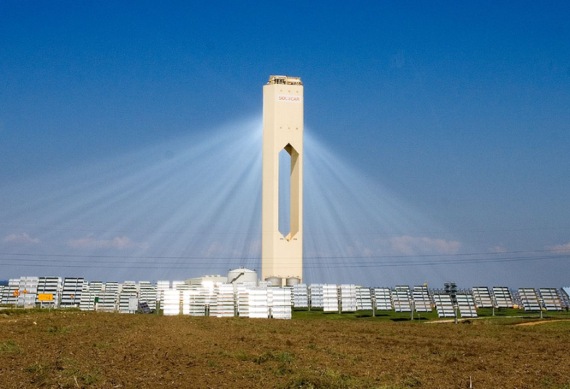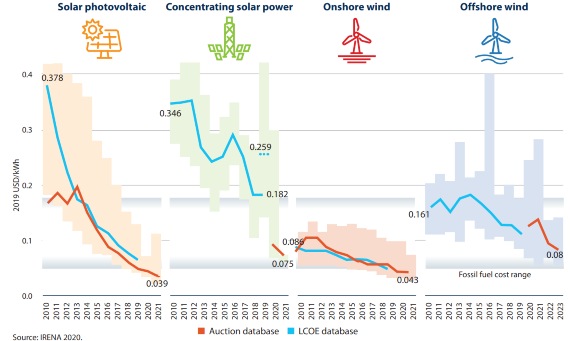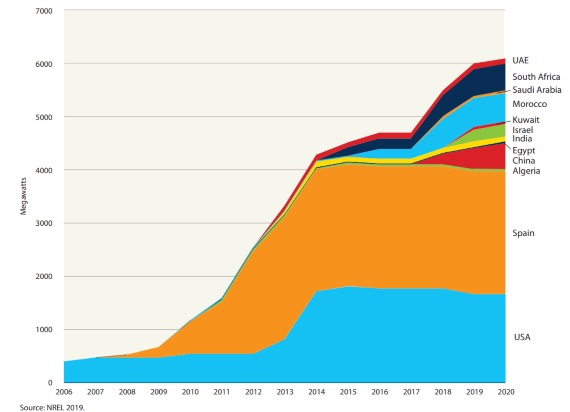In the previous article, I described the essential principles of thermosolar technology or concentrated solar power (CSP). In this article, I analyze the advantages and disadvantages of this technology in order to understand what factors hinder its massive roll-out. The following image shows a diagram of the essential components of a CSP plant that uses a concentrating tower.
On paper, this technology has several benefits, but also some disadvantages. I analyze them below:
This factor – essential in any power plant – depends on several factors in the case of CSP: the reflective mirror’s capacity to concentrate solar radiation, the temperature that the transfer fluid reaches and the capture area. In today’s operational systems, efficiency is understood as between 20 percent to 40 percent – comparable, and even higher values than those of the other great system converting solar energy into electricity, photovoltaic solar energy, whose commercial efficiency ranges between 18 percent to 26 percent. The conversion efficiency values of CSP plants can also compete favorably with coal or nuclear power plants, whose energy efficiency are around 35 percent, although they are lower than that of combined cycle power plants that use natural gas (45 percent to 50 percent).

Together with energy efficiency, CSP storage capacity is the driving factor for the incorporation of this technology in the energy mix on equal terms as other, more mature renewable technologies, such as photovoltaic or wind. CSP plants can store thermal energy for 10 to 15 hours, and this is their key factor. Thanks to this ability, the production curve of CSP plants fits perfectly with the curve for the electricity demand, which ensures that continuous supply can be guaranteed 24 hours a day with this technology. At the end of 2021, it was estimated that there was 23 GWh of storage of the thermal energy produced at CSP plants, based nearly entirely on molten salt technology.
The rise of wind and photovoltaic solar power has demonstrated the need for renewable technologies that can contribute to the flexible functioning of electric systems in order to ensure the reliability of the electricity supply. As is well known, wind and photovoltaic solar power are variables, which means that their production fluctuates based on the availability of sun and wind, respectively. The fluctuations in the production of renewable energy variables must be carefully managed. If they have a high penetration index, they could compromise the reliability of the network; if not planned properly, it could cause voltage drops and blackouts.

Solucar PS10 is a thermoelectric solar power plant with tower technology – the first commercial plant in the world
CSP with storage for thermal energy offers a solution as it makes it possible to store solar energy and feed electricity to the grid at short notice to complement the production flows of renewable variables. The most evident example of this is when the photovoltaic production falls at the end of the afternoon and CSP with thermal energy storage releases the stored energy to meet the demand. But CSP can also do the opposite. In other words, when photovoltaic production reaches its highest point, the CSP plant can stop feeding electricity to the grid and store the energy as heat, which can be used when needed, even at night. In this regard, CSP and photovoltaic solar energy are perfectly complementary.
This is an important inconvenience of this technology, as it requires high levels of solar irradiance for extended periods of time. This means its rollout is limited exclusively to countries or regions that meet these requirements. Only in places with high levels of solar irradiance – over 2,000 kWh/m2.year, typical in southern Europe and northern Africa – can CSP plants be rolled out at competitive costs.
For the moment, this is the biggest factor that is impeding its development. However, given the trends observed since 2007, the prices of the electricity obtained with CSP technology are expected to continue declining in the coming years if the roll-outs continue to increase. The new plants will incorporate technological advances, improve economies of scale and enhance the efficiencies of both the construction and functioning of these plants. The figure demonstrates this.

More and more countries are using CSP with thermal energy storage. In recent years, CSP plants have been installed mainly in African and Asian countries, moving away from the regions where this technology was originally installed (North America and Europe). In line with the development of other renewable technologies, more CSP projects are likely to be developed as the costs continue to drop, but greater stability in the regulatory frameworks would be welcome to develop the scale of installations needed to ensure that costs decline.

In 2022, installed power fell slightly for the first time due to the decommissioning of nearly 300 MW of old power plants using CSP technology in the U.S. However, the global market continues to show net growth this year, with the installation of 750 mW of new capacity in China and the United Arab Emirates.
Spain is the country with the most CSP installations in the world – a total of nearly 50 power plant that add up to 2,300 MW – and it is the global leader of this technology. In the year 2021, CSP generation reached 4,719 GWh, which represents 1.84 percent of the total demand for electricity that year.
To date, CSP has not been able to compete with photovoltaic energy commercially on a global level. In order for CSP to be competitive, the cost of the electricity produced must decline. Given that the conversion efficiencies of thermal energy rise with a temperature increase, which is well known thanks to the second law of thermodynamics, the trend in research is improvement in the central receiver tower technology in order to increase the conversion temperatures to around 700ºC to 800ºC. And given that it is not practical to use steam at such high temperatures, the current goal is to find a replacement for steam and use molten salt instead as a heat storage element. In concentrating towers, and in those in the first figure of this article, a combination of sodium nitrates and potassium is heated until it reaches 600ºC to 800ºC. These molten salts are then stored in thermally isolated deposits in the ground. Then, the way in which electricity is obtained is the normal method: the molten salts are diverted to a heat exchanger that produces steam. When it is moved toward a turbine at high pressure, it produces electricity.
In the coming years, we will see a greater number of these power plants in very sunny countries, although the costs must decline significantly to catch up with photovoltaic energy.
Professor of Electronics at the Complutense University of Madrid and member of the Spanish Royal Society of Physics
Author of the book Energía solar: De la utopía a la esperanza (Análisis y crítica)